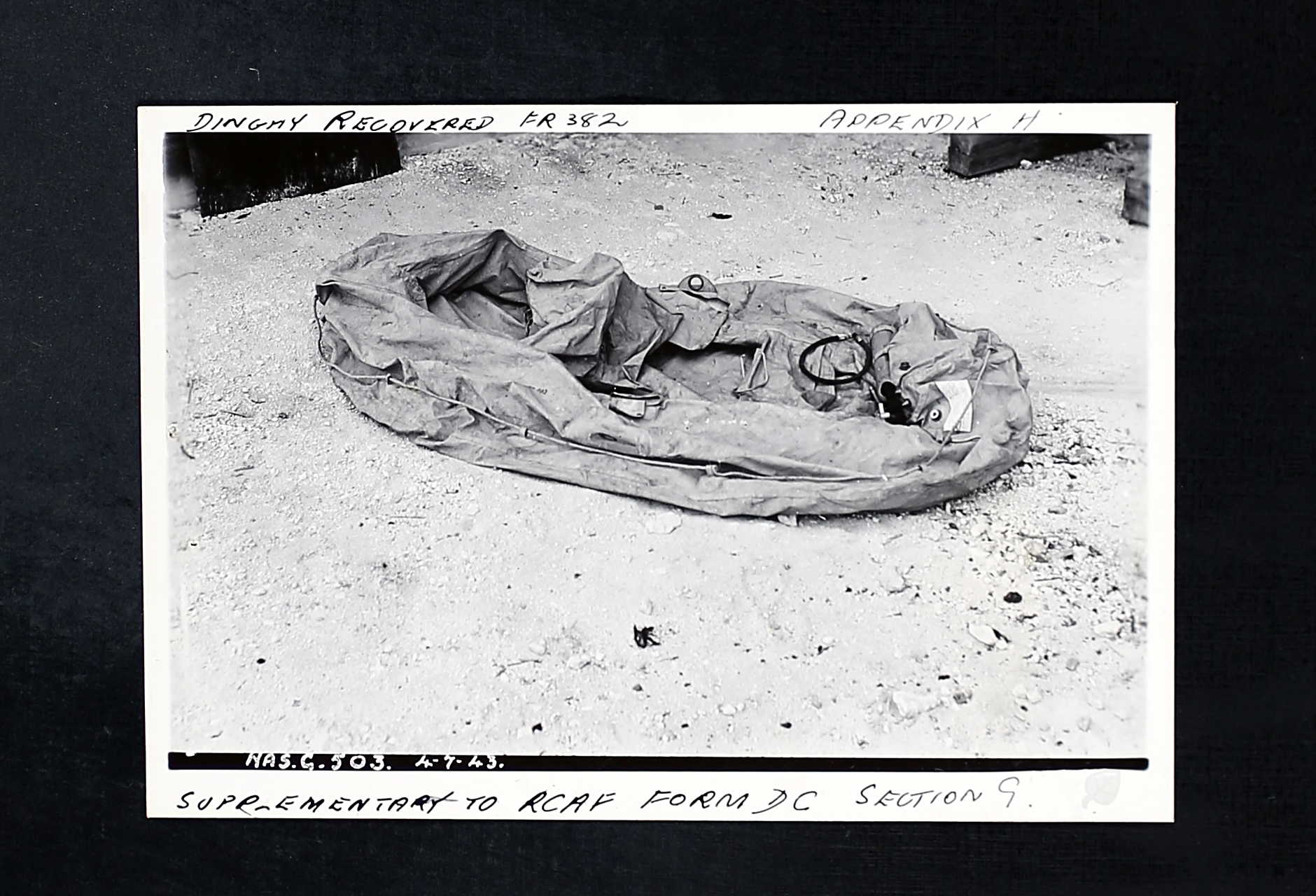
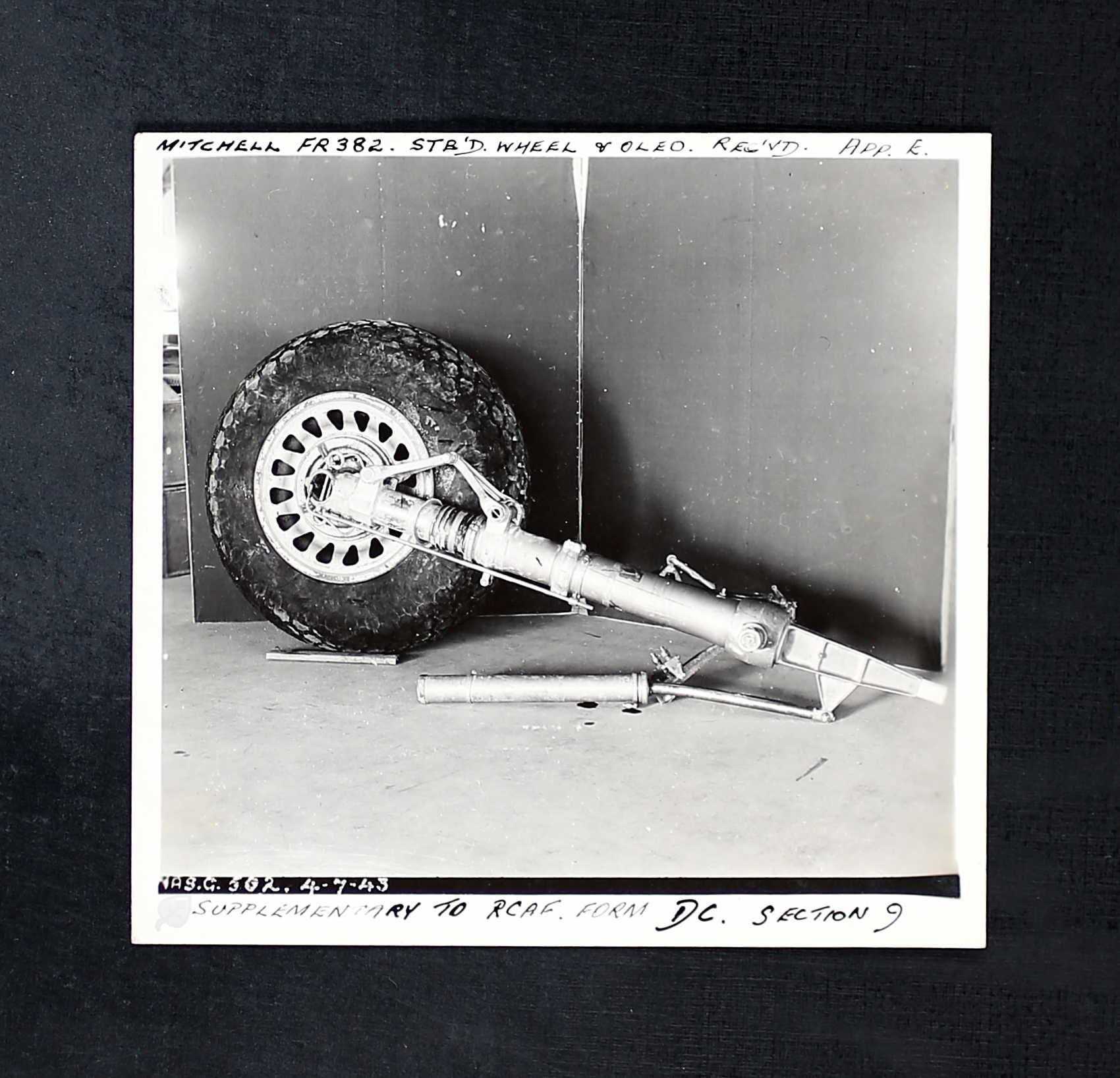
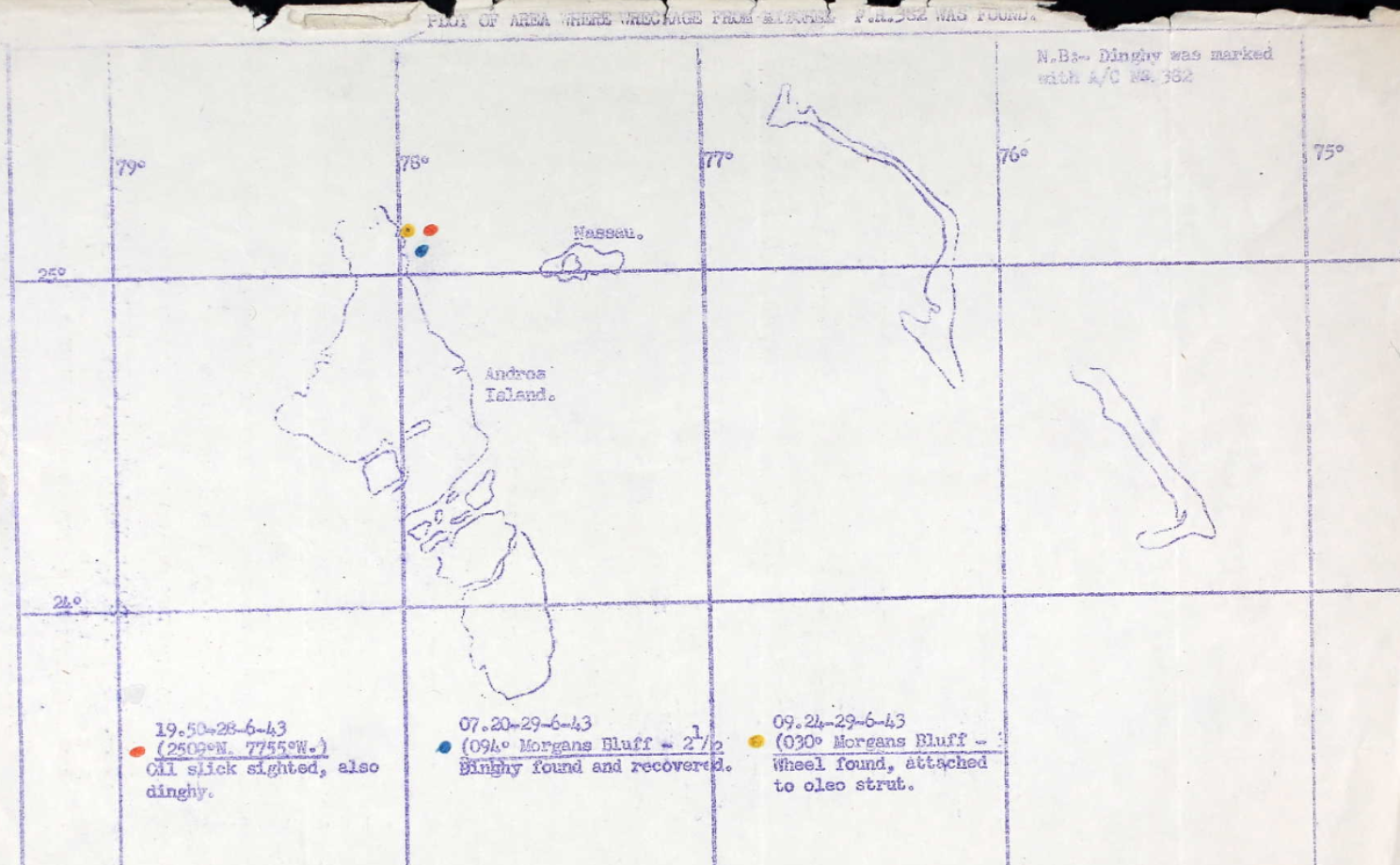
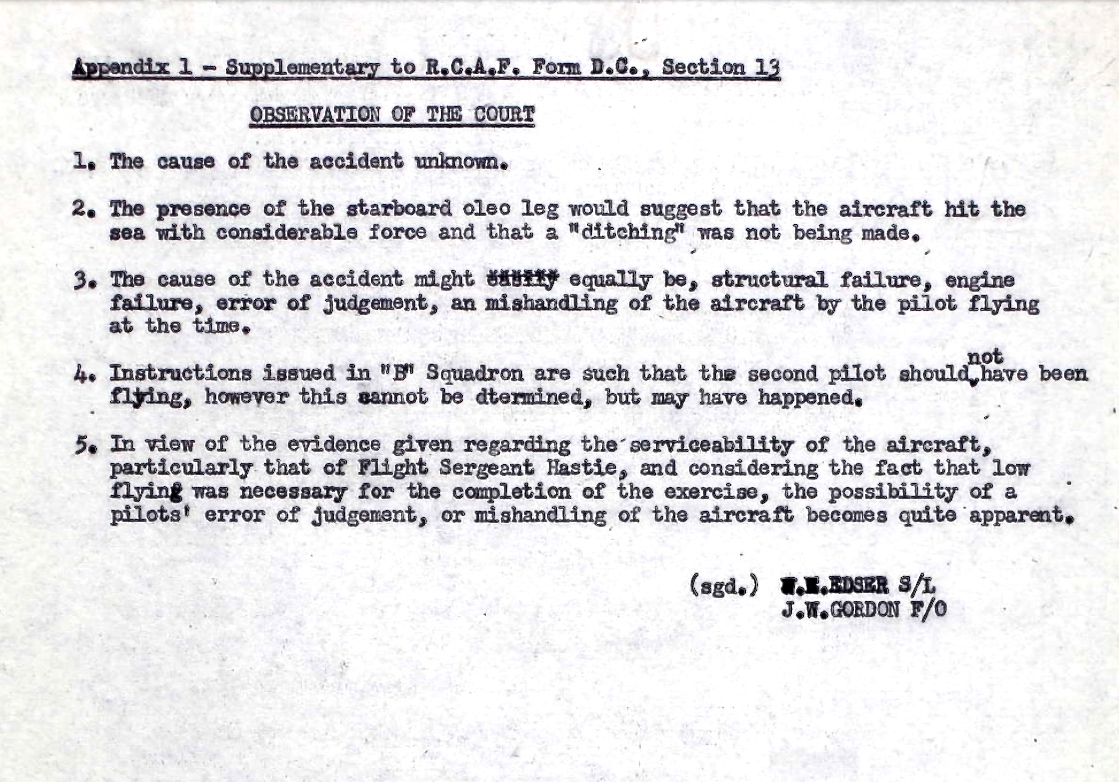
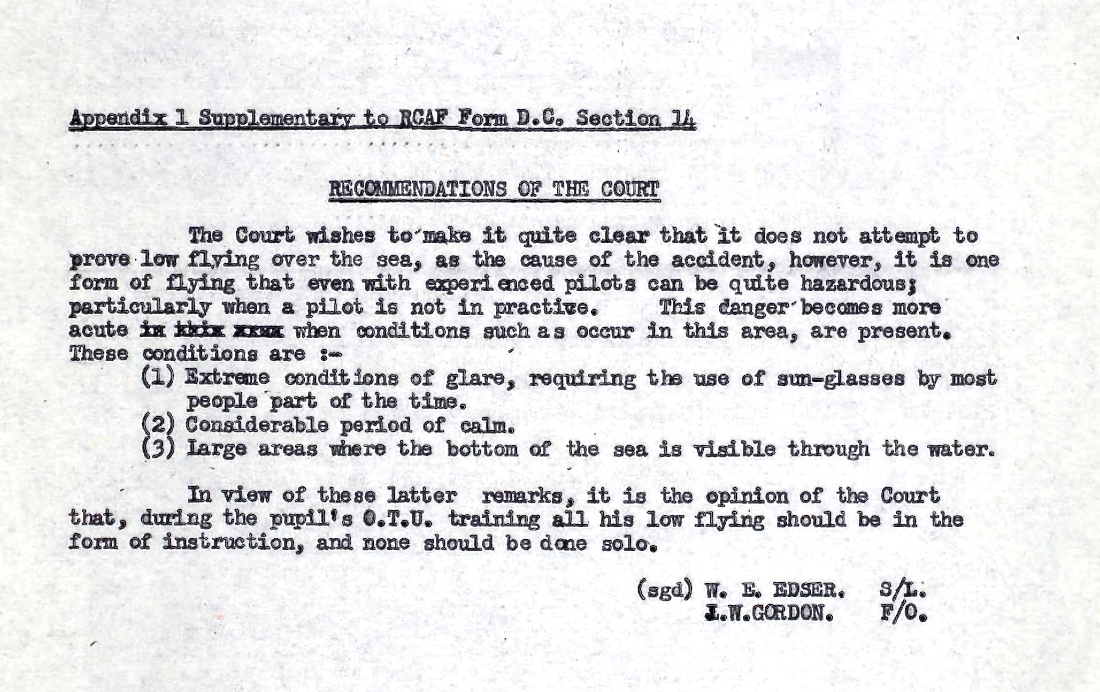
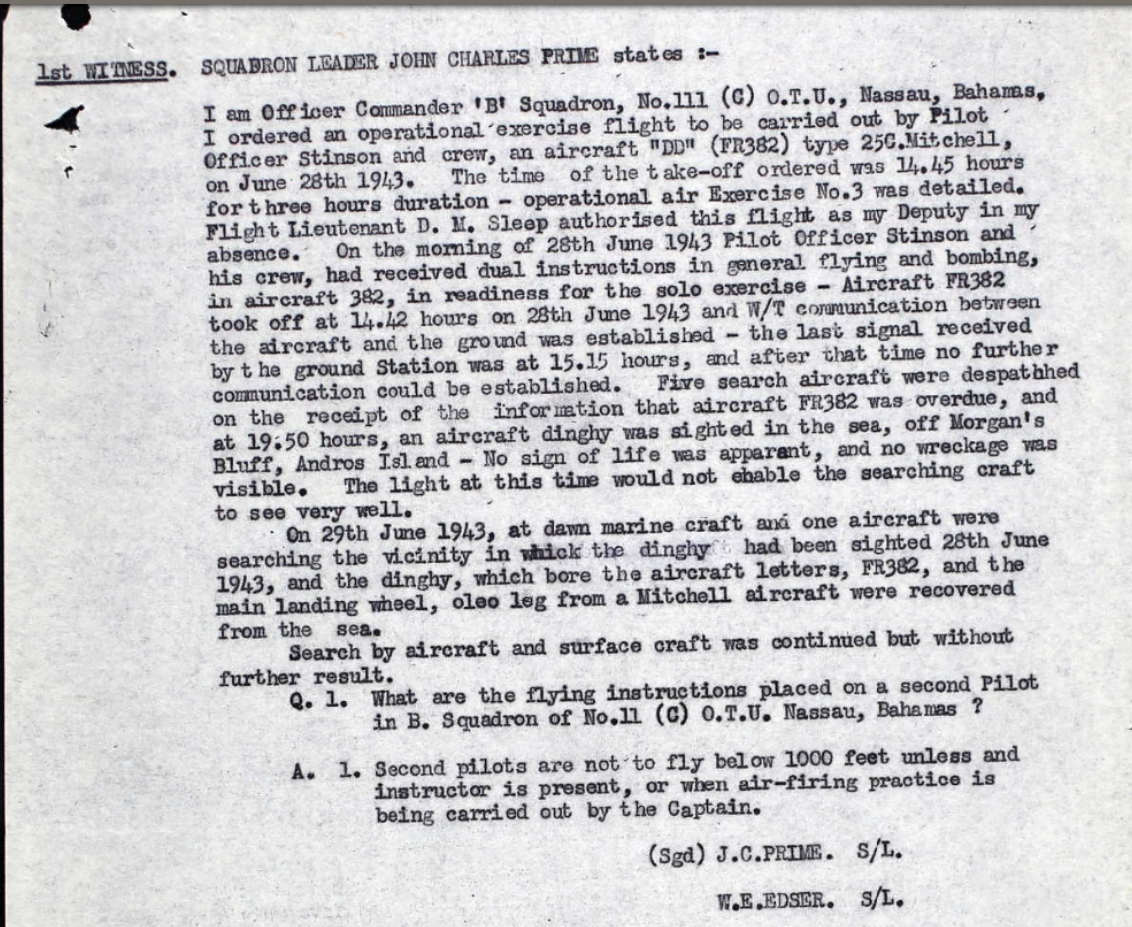
December 23, 1923 - June 28, 1943






William Lorne Stinson, born in Virden, Manitoba, was the son of John Christopher Stinson and Aldyth Lavina (nee Churchill) Stinson of Port Arthur, Ontario. He had one brother, Clifford John Stinson, RCC Signals, Canadian Army Overseas. Mr. Stinson was a sergeant with 23 Active Coy. VGC, in Port Arthur, Ontario. The family attended the United Church.
He had a Grade XI education and was unemployed at the time of his enlistment in Winnipeg on January 6, 1942. He had been working as a waiter for six months between June and December 1941 at the Manitoba Club, but “disliked occupation,” so he quit. He had no hobbies, but enjoyed swimming and softball, occasionally.
He stood 5’9” tall and weighed 133 pounds. “Average pilot material. Rather young and immature. Otherwise good type. Fit. Underweight.” Three scars on his left leg below the knee were noted. He had blue eyes and black hair with a medium complexion.
While at Brandon, Manitoba at No. 2 Manning Depot, William was in the hospital from March 16-30, 1942.
He was sent to RCAF Station, East Calgary, April 11, 1942 until May 9, 1942, then sent to No. 4 ITS Edmonton, May 10, 1942 until August 29, 1942. “LINK: 56%. Irish descent. Father, farmer and WWI veteran. Quiet, unassuming, alert, serious type, young, keen. Alternative: WAG.”
From there, he was sent to No. 5 EFTS, High River, Alberta from August 30 to October 24, 1942. “High average ground school. Average flying ability. Has had slight trouble with steep turns, inclined to be nervous. Needs checking on airmanship. Conduct excellent.”
No. 7 SFTS, Macleod was next until February 26, 1943, where he earned his Pilot’s Flying Badge. “A high average student, while rather young and immature, is quite confident. Recommended for a commission.”
He was sent to No. 1 GRS, Summerside, PEI February 27, 1943 until May 2, 1943. He was then at No. 5 Manning Depot Lachine, Quebec until May 11, 1943 when he was sent to No. 111 O.T.U. Nassau, Bahamas May 15, 1943.
Aboard Mitchell FR 382, seven aircrew lost their lives while engaged in low level attack exercises over the sea on June 28, 1943. The last communication was at 1915 hours. At 2253, Signals supervisor stated no mention off anything abnormal at change of watch at 2100. At 2350, a dinghy was sighted and later recovered on June 29th at 1120 from the sea 15 miles NE of Nassau, Bahamas. No further news of the aircraft of crew was received. Searches were made to search north and east beaches twenty miles for possibly parachutes. A wheel and spar were also recovered. Those aboard were Sgt. James Bryan Keayes, A421283 (RAAF), son of James Lawrence Keayes and Cecelia Keayes, Nambucca Heads, NSW, Australia, Sgt. Arthur William Torrens, A413287 (RAAF), son of Thomas B. Torrens and Esther Georgina Torrens, Ballina, NSW, Australia, Sgt. Charles Leslie Herbert Snart, 552206 (RAF), Pilot Officer William Lorne Stinson, J23911 (RCAF), son of John C. Stinson and Aldyth Lovina Stinson of Port Arthur, Ontario, Sgt. Thomas Wallace, R168519 (RCAF), son of Hugh W. Wallace and Agnes Wallace of Vancouver, BC, Sgt. Carl Eric Ogren, R166219 (RCAF), son of Harold Gustav and Elizabeth Ogren of Winnipeg, Manitoba, and Sgt. Arthur Joseph Beaulieu, R157081, of Vancouver, BC.
A Court of Inquiry was struck with eight witnesses. Visibility more than 15 miles. Weather fair with possible scattered showers. “Occupants were not instructing each other.”
The first witness, S/L John Charles Prime stated that he was the OC ‘B’ Squadron No. 111 C O.T.U. Nassau, Bahamas. “I ordered an operational exercise flight to be carried out by P/O Stinson and crew, an aircraft DD (FR382) type 25C Mitchell on June 28, 1943. The time of the take-off ordered was 1445 hours for three hours’ duration. Operational air exercise No. 3 was detailed. F/L D. M. Sleep authorized this flight as my deputy in my absence. On the morning of 28th June 1943, P/O Stinson and his crew, had received dual instructions in general flying and bombing, in aircraft 382, in readiness for the solo exercise. Aircraft FR382 took off at 1442 hours on 28th June 1943 and W/T communication between the aircraft and the ground was established, the last signal received by the ground station was at 1515 hours and after that time no further communications could be established. Five search aircraft were despatched on the receipt of the information that the aircraft FR382 was overdue and at 1950 hours, an aircraft dinghy was sighted in the sea, off Morgan’s Bluff, Andros island. No sign of life was apparent and no wreckage was visible. The light at this time would not enable the searching aircraft to see very well. On 29th June 1943, at dawn, marine craft and one aircraft were searching in the vicinity in which dinghy had been sighted 28th June 1943 and the dinghy which bore the aircraft letters FR382 and the main landing wheel, oleo leg from a Mitchell aircraft were recovered from the sea. Search by aircraft and surface craft was continued by without further result. Second pilots are not to fly below 1000 feet unless an instructor is present or when air-firing practice is being carried out by the Captain.”
The seventh witness, F/S Robert Miller Hastie, 1107486, stated, “I am a flying instructor in B Squadron, No. 111 C O.T.U. Nassau, Bahamas. I gave instruction in 50’ A.S. Bombing to P/O Stinson and to Sgt. Torrens during the forenoon June 29, 1943. We flew Mitchell FR382. P/O Stinson’s low level bombing was average, Sgt. Torren’s low level bombing was average for second pilot. He was below standard for a first pilot, though this was my first flight with him, that was the impression I gained during the twenty minutes he was flying.”
The eighth witness, F/O Alan John Laird Craig, flying instructor stated that “I was Sgt. Torren’s instructor during his conversion on to Mitchell aircraft. Sgt. Torren’s flying, in my estimation, was below the average on Mitchells. I have had approximately 500 hours of instruction.”
“OBSERVATIONS OF THE COURT: (1) The cause of the accident is unknown. (2) The presence of the starboard oleo leg would suggest that the aircraft hit the sea with considerable force and that a ditching was not being made. (3) The cause of the accident might equally be, structural failure, engine failure, error of judgement, a mishandling of the aircraft by the pilot flying at the time. (4) Instructions issued in ‘B’ Squadron are such that the second pilot should not have been flying, however, this cannot be determined, but may have happened. (5) In view of the evidence given regarding the serviceability of the aircraft, particularly that of F/S Hastie, and considering the fact that low flying was necessary for the completion of the exercise, the possibility of a pilot’s error of judgement, or mishandling of the aircraft becomes quite apparent.
RECOMMENDATIONS OF THE COURT: The Court wishes to make it quite clear that it does not attempt to prove low flying over the sea, as it is the cause of the accident; however, it is one form of flying that even with experienced pilots can be quite hazardous; particularly when a pilot is not in practice. This danger becomes more acute when conditions such as occur in this area, are present. These conditions are: (1) Extreme conditions of glare, requiring the use of sun-glasses by most people part of the time (2) Considerable period of calm (3) Large areas where the bottom of the sea is visible through the water. In view of these remarks, it is the opinion of the Court that, during the pupil’s O.T.U. training, all his low flying should be in the form of instruction and none should be done solo.”
Other recommendations: Low flying over the sea not to be carried out when sunglasses are being worn, when the bottom of the sea is visible through the water, when the water is calm, into the sun, unless an instructor is with the pupil. Air to see firing practice is not to be carried out below 350’. S/L Vare stated that “Low level bombing and gunnery practice must be continued as a solo exercise. Orders are such that the height will not be less than 50’ and 500’ respectively.” G/C Waite stated, “I do not agree with the final paragraph of the recommendations. Great care is taken in teaching low flying and pilots must acquire practice and confidence.” July 10, 1943.
The scene of the accident was not visited “as aircraft in six hundred fathoms of water.”
On June 30, 1943, Mrs. Stinson received a telegram. “REGRET TO ADVISE THAT YOUR SON PILOT OFFICER WILLIAM LORNE STINSON J23811 IS REPORTED MISING BELIEVED KILLED RESULT FLYING OPERATIONS JUNE 28 STOP PLASE ACCEPT MY SINCERE SYMPATHY STOP LETTER FOLLOWS.”
She wrote a letter on July 16, 1943: “Am I asking too much when I ask if you could tell me if he was flying out of Nassau and where they were believe to have gone down. Also will I receive any of his personal belongings from his base. Is there any chance they could have been picked up?”
In late October 1955, Mrs. Stinson, residing in Virden, Manitoba, was informed that since William had no known grave, his name would appear on the Ottawa Memorial. She later moved to New Westminster, BC. William’s medals were returned undelivered and returned to stock.